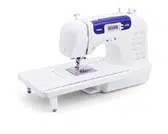Documents: Go to download!
User Manual
- Owner's manual - (English)
- Quick Start Guide - (English)
- Accessories catalog - (English)
- NAMES OF MACHINE PARTS AND THEIR FUNCTIONS
- USING YOUR SEWING MACHINE
- THREADING THE MACHINE
- REPLACING THE NEEDLE
- REPLACING THE PRESSER FOOT
- SEWING
- ADJUSTING THE STITCH LENGTH AND WIDTH
- MAINTENANCE
- TROUBLESHOOTING
- ERROR MESSAGES
Table of contents
NAMES OF MACHINE PARTS AND THEIR FUNCTIONS
The main parts
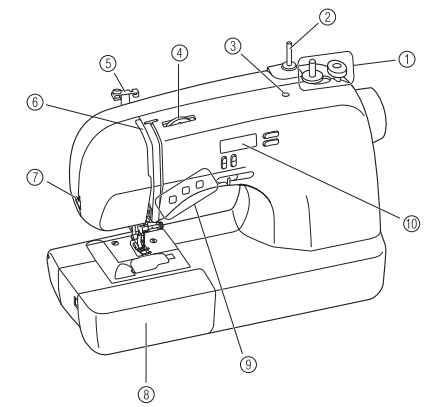

- Bobbin winder
- Spool pin
- Hole for extra spool pin
- Upper tension-control dial
- Thread guide
- Thread take-up lever
- Thread cutter
- Flat bed attachment with accessory compartment
- Operation buttons
- Operation panel
- Handwhee:l Used to manually raise and lower the needle.
- Air vent: This vent allows the air surrounding the motor to circulate. Do not cover the air vent while the sewing machine is being used.
- Main power and sewing light switch
- Jack/socket connector
- Foot controller
- Foot controller jack/socket
- Feed dog position lever
- Presser foot lever
- Handle: Carry the sewing machine by its handle when transporting the machine
Needle and presser foot section
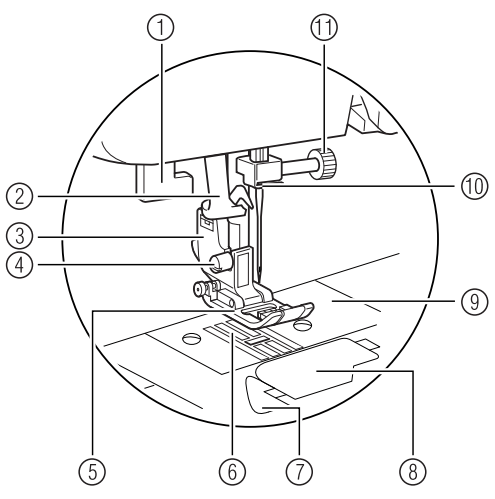
- Buttonhole lever
- Needle threader (for models equipped with the needle threader)
- Presser foot holder: The presser foot is installed onto the presser foot holder.
- Presser foot holder screw: Use the presser foot holder screw to hold the presser foot holder in place.
- Presser foot: The presser foot applies pressure consistently on the fabric as the sewing takes place. Attach the appropriate presser foot for the selected stitching.
- Feed dogs: The feed dogs feed the fabric in the sewing direction.
- Quick-set bobbin (for models equipped with the quick-set bobbin): You can start sewing without pulling up the bobbin thread.
- Bobbin cover
- Needle plate: The needle plate is marked with guides for sewing straight seams.
- Needle bar thread guide
- Needle clamp screw
Operation buttons
The operation buttons differ depending on the sewing machine model.

1. Presser foot lever
Raise and lower the presser foot.
2. Reverse/reinforcement stitch button 
Press the reverse/reinforcement stitch button to sew reverse stitches. Reverse stitches are sewn by keeping the button pressed down to sew in the opposite direction.
Buttons provided on some models
3. Start/stop button 
Press the start/stop button to start or stop sewing. The machine sews at a slow speed at the beginning of sewing while the button is depressed. When sewing is stopped, the needle is lowered in the fabric.
4. Needle position button 
Press the needle position button to raise or lower the needle. Pressing the button twice sews one stitch.
5. Sewing speed controller
Slide this controller to adjust the sewing speed.
Operation panel
The operation panel allows you to select a stitch and specify how the stitch will be sewn.
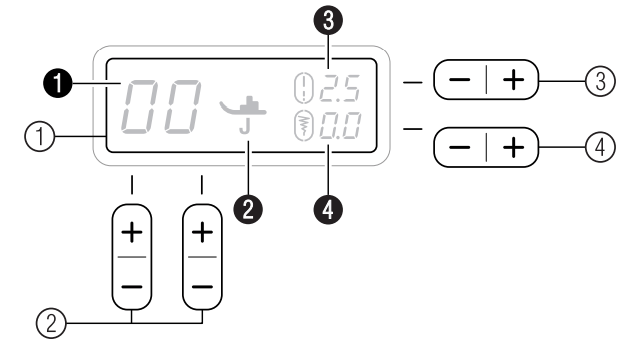
1. LCD (Liquid crystal display)
The selected stitch  , presser foot that should be used
, presser foot that should be used  , stitch length in millimeters
, stitch length in millimeters  , and stitch width in millimeters
, and stitch width in millimeters  are displayed.
are displayed.
2. Stitch selection keys
Select the number for the stitch that you wish to use.
3. Stitch length adjustment ke
Press the “–” side to reduce the stitch length; press the “+” side to increase the stitch length.
4. Stitch width adjustment key
Press the “–” side to reduce the stitch width; press the “+” side to increase the stitch width.
Flat bed attachment
The accessories are stored in a compartment inside the flat bed attachment.
1. Slide the flat bed attachment to the left to open it

(1) Flat bed attachment
(2) Storage compartment
Note: Put the accessories in the bag, and then store the bag inside the compartment. If the accessories are not in a bag, they may fall out, and be lost or damaged.
USING YOUR SEWING MACHINE
Power supply
1. Insert the plug into a wall outlet
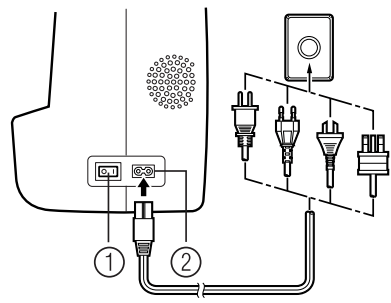
(1) Main power switch
(2) Jack/socket connector
2. Set the main power switch to “I”
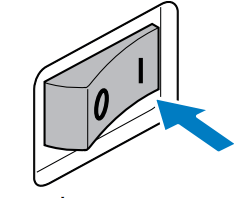
The sewing lamp comes on when the machine is turned on
3. To turn off the machine, set the main power switch to “O”
The sewing lamp goes of when the machine is turned off.
Note:
- If a power outage occurs while the sewing machine is being operated, turn off the sewing machine and unplug the power supply cord. When restarting the sewing machine, follow the necessary procedure to correctly operate the machine.
- This appliance has a polarized plug (one blade wider than the other). To reduce the risk of electric shock, this plug is intended to fit in a polarized outlet only one way. If the plug does not fit fully in the outlet, reverse the plug. If it still does not fit, contact a qualified electrician to install the proper outlet. Do not modify the plug in any way.
Foot controller
Insert the foot controller plug into its jack/socket.
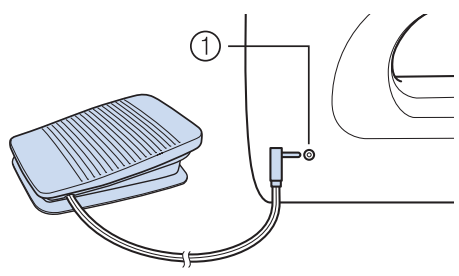
(1) Foot controller jack/socket
CAUTION: When connecting the foot controller, be sure to turn off the sewing machine in order to prevent the machine from accidentally being started.
Depress the foot controller to start sewing, and adjust the sewing speed by changing the pressing force.
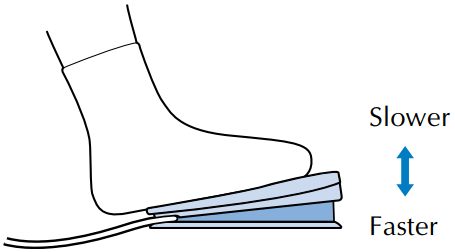
You should make sure that nothing is placed on the foot controller when the machine is not in use.
CAUTION: Do not allow pieces of cloth and dust to build up on the foot controller. Doing so could cause a fire or an electric shock.
Note: When the foot controller is plugged in, the start/ stop button cannot be used to start or stop sewing (only for models equipped with the start/stop button).
Sewing speed controller (for models equipped with the start/stop button)
1. Slide the sewing speed controller to select the desired sewing speed.
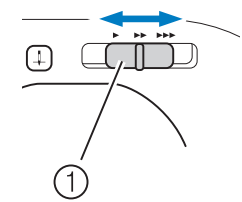
(1) Sewing speed controller
The speed set using the sewing speed controller is the foot controller’s maximum sewing speed.
Changing the needle stop position
Normally, the sewing machine is set to leave the needle in the fabric when sewing is stopped. Instead, the machine can be set to leave the needle raised when sewing is stopped.
1. Turn off the sewing machine
2. Hold down the “–” side of  (1) on he left and turn on the sewing machine.
(1) on he left and turn on the sewing machine.
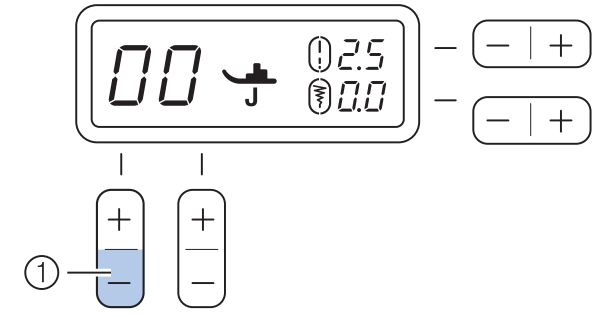
3. After turning on the sewing machine, release the “–” side of  (1).
(1).
The needle stop position changes to the raised position.
Memo: The needle stop position changes to the raised position.
THREADING THE MACHINE
Winding the bobbin

(1) Pre-tension disk
(2) Bobbin winder shaft
(3) Bobbin
1. Pull up the spool pin as far as possible, and then put a spool of thread on this pin
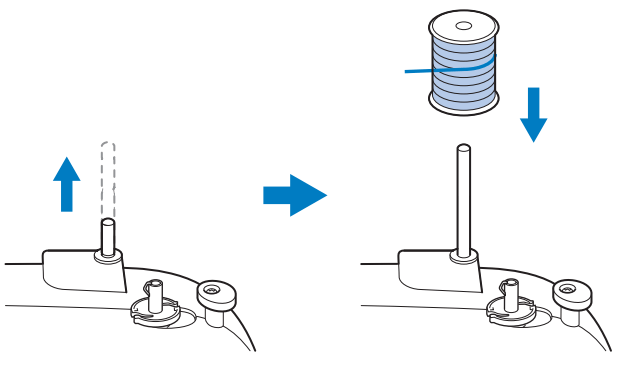
2. Pass the thread around the pre-tension disk

CAUTION: If the spool of thread is not in the right place, the thread may tangle on the spool pin.
3. Pass the end of the thread through the hole on the bobbin from the inside of the bobbin
4. Put the bobbin onto the bobbin winder shaft and slide the bobbin winder shaft to the right. Turn the bobbin clockwise, by hand, until the spring on the shaft slides into the groove of the bobbin.

(1) Spring on the shaft
(2) Groove of the bobbin
5. Turn on the sewing machine
6. While holding the end of the thread, gently press the foot controller or press  (start/stop button) (for models equipped with the start/stop button) to wind the thread around the bobbin a few times. Then stop the machine. Then stop the machine and trim the excess thread.
(start/stop button) (for models equipped with the start/stop button) to wind the thread around the bobbin a few times. Then stop the machine. Then stop the machine and trim the excess thread.
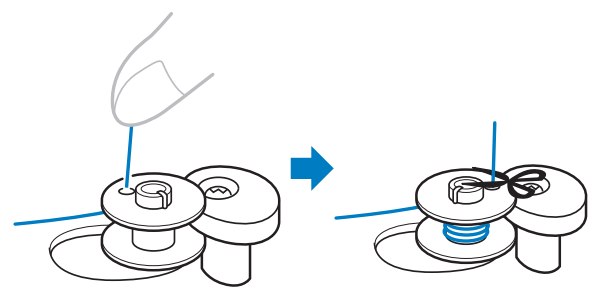
Note:
- If the sewing machine is to be operated using the foot controller, connect the foot controller before turning on the machine.
- When the foot controller is plugged in, the start/ stop button cannot be used to start or stop sewing (only for models equipped with the start/stop button).
CAUTION: Make sure you follow the instructions carefully. If you do not cut the thread completely, and the bobbin is wound, when the thread runs low it may tangle around the bobbin and cause the needle to break.
7. Slide the sewing speed controller to the right (to set the speed to fast). (For models equipped with the sewing speed controller.)

(1) Sewing speed controller
8. Press the foot controller or press  (start/stop button) (for models equipped with the start/stop button) to start.
(start/stop button) (for models equipped with the start/stop button) to start.

9. When the bobbin seems full and begins spinning slowly, take your foot off the foot controller or press  (start/stop button) (for models equipped with the start/stop button).
(start/stop button) (for models equipped with the start/stop button).
10. Cut the thread, slide the bobbin winder shaft to the left and remove the bobbin.
11. Slide the sewing speed controller back to its original position (for models equipped with the sewing speed controller).
Memo:
- When the sewing machine is started or the handwheel is turned after winding the thread around the bobbin, the machine will make a clicking sound; this is not a malfunction.
- The needle bar does not move when you slide the bobbin winding shaft to the right.
CAUTION: Not winding the bobbin properly may cause the thread tension to loosen, and may break the needle.

(1) Wound evenly
(2) Wound poorly
For models equipped with the fast bobbin winding system
1. Follow steps 1 through 2 of the procedure in “Winding the bobbin” to pass the thread around the pre-tension disk
2. Place the bobbin on the bobbin winder shaft so that the spring on the shaft fits into the notch in the bobbin. Then slide the bobbin winder shaft to the right.
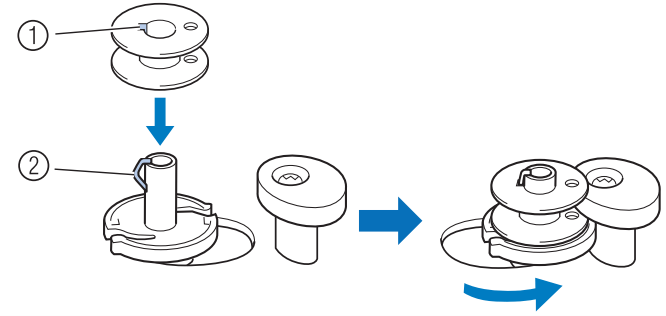
(1) Notch
(2) Spring
3. Wind the free end of the thread clockwise around the bobbin five or six times.
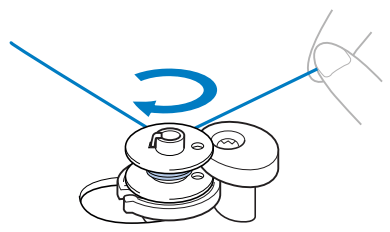
4. Pull the thread to the right and pass it through the slit in the bobbin winder seat.
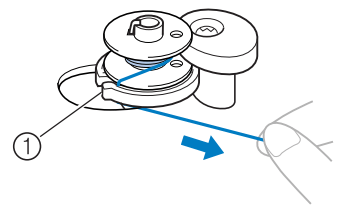
(1) Slit (with built-in cutter)
The thread is cut to a suitable length.
CAUTION: Be sure to cut the thread as described. If the bobbin is wound without cutting the thread using the cutter built into the slit in the bobbin winder seat, the thread may become tangled in the bobbin or the needle may bend or break when the bobbin thread starts to run out.
5. Slide the sewing speed controller to the right (to set the speed to fast) (for models equipped with the sewing speed controller).

(1) Sewing speed controller
6. Turn on the sewing machine.
7. Press the foot controller or press  (start/stop button) (for models equipped with the start/stop button) to start.
(start/stop button) (for models equipped with the start/stop button) to start.
Note:
- If the sewing machine is to be operated using the foot controller, connect the foot controller before turning on the machine.
- When the foot controller is plugged in, the start/ stop button cannot be used to start or stop sewing (only for models equipped with the start/stop button).
8. When the bobbin begins spinning slowly, take your foot off the foot controller or press  start/stop button) (for models equipped with the start/stop button).
start/stop button) (for models equipped with the start/stop button).
9. Cut the thread, slide the bobbin winder shaft to the left and remove the bobbin.
10. Slide the sewing speed controller back to its original position (for models equipped with the sewing speed controller).
Memo:
- When the sewing machine is started or the handwheel is turned after winding the thread around the bobbin, the machine will make a clicking sound; this is not a malfunction.
- The needle bar does not move when you slide the bobbin winding shaft to the right.
Lower threading
Install the bobbin wound with thread.
CAUTION: Winding the bobbin improperly may cause the thread tension to loosen, breaking the needle and resulting in injury.

(1) Wound evenly
(2) Wound poorly
Make sure you turn the power off while threading the machine. If you accidentally step on the foot controller and the machine starts to sew, you could be injured.
1. Raise the needle to its highest position by turning the handwheel toward you (counterclockwise) or press  (needle position button) (for models equipped with the needle position button), and raise the presser foot lever
(needle position button) (for models equipped with the needle position button), and raise the presser foot lever
2. Slide the button and open the cover.
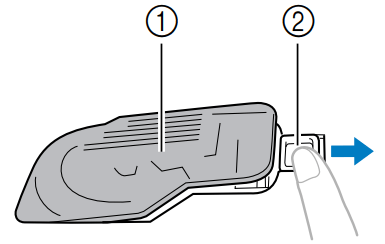
(1) Cover
(2) Slide button
3. Put the bobbin in so the thread comes out in the direction shown by the arrow.
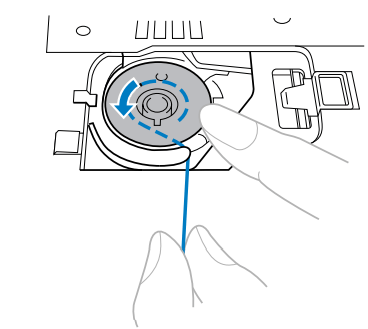
CAUTION: Make sure you set the bobbin so the thread unrolls in the right direction. If the thread unrolls in the wrong direction, it may cause the thread tension to be incorrect or break the needle.
4. Hold the end of the thread, push the bobbin down with your finger, and then pass the thread through the slit, as shown.
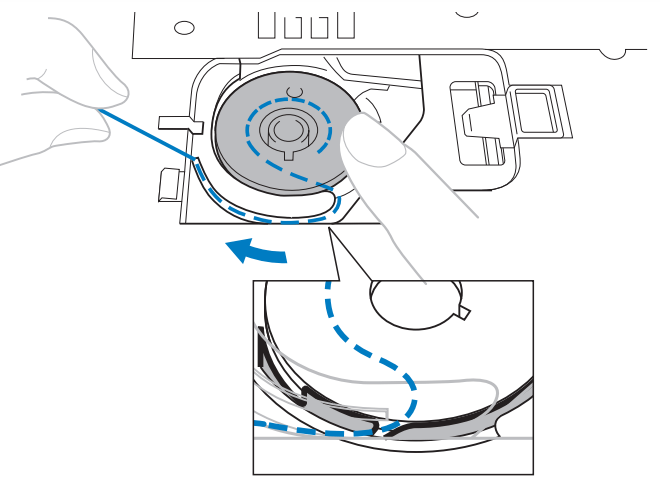
5. Replace the bobbin cover.
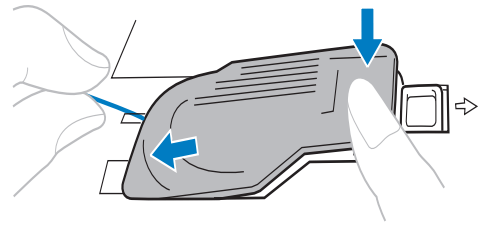
Replace the cover so that the end of the thread comes out from the left side of the cover (as shown by the line in the diagram).
For models equipped with the quick-set bobbin
1. Raise the needle to its highest position by turning the handwheel toward you (counterclockwise) or press  (needle position button) (for models equipped with the needle position button), and raise the presser foot lever.
(needle position button) (for models equipped with the needle position button), and raise the presser foot lever.
2. Slide the button and open the cover.
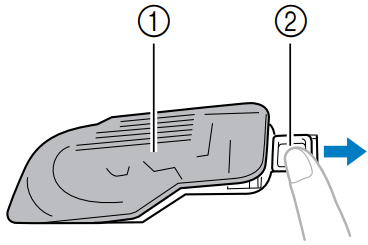
(1) Cover
(2) Slide button
3. Put the bobbin in, feed the end of the thread, through the slit, and then pull the thread to cut it.

(1) Cutter
CAUTION: Make sure you set the bobbin so the thread unrolls in the right direction. If the thread unrolls in the wrong direction, it may cause the thread tension to be incorrect or break the needle.
Make sure that the thread is correctly inserted through the tension-adjusting spring of the bobbin case. If it is not inserted, re-insert the thread.
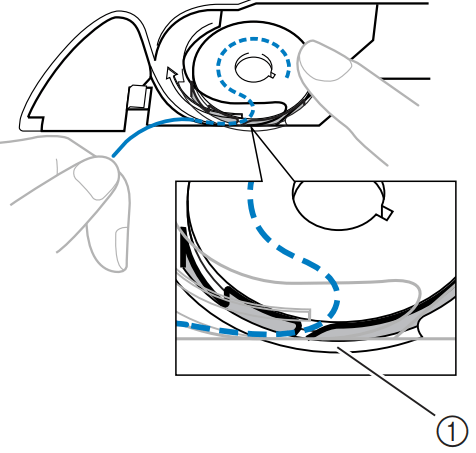
(1) Tension-adjusting spring
Memo: The direction for feeding the bobbin thread is indicated by marks on the needle plate cover. Be sure to thread the machine as indicated.
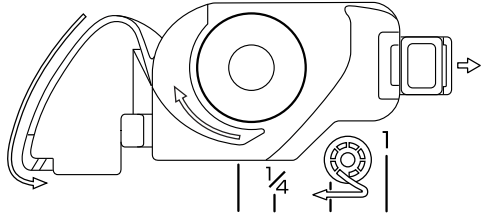
4. Replace the bobbin cover.
Memo: You can begin sewing immediately without drawing up the bobbin thread. If you want to draw up the bobbin thread before you start to sew, follow to the procedure in “Drawing up the lower thread”
Upper threading
Set the upper thread and thread the needle.

(1) Spool pin
(2) Thread guide
(3) Mark on the handwheel
CAUTION: Make sure you thread the machine properly. Otherwise, the thread could tangle and break the needle.
1. Raise the presser foot using the presser foot lever.

(1) Presser foot lever
2. Raise the needle by turning the handwheel toward you (counterclockwise) so that the mark on the wheel points up, or press  (needle position button) (for models equipped with the needle position button) once or twice to raise the needle.
(needle position button) (for models equipped with the needle position button) once or twice to raise the needle.
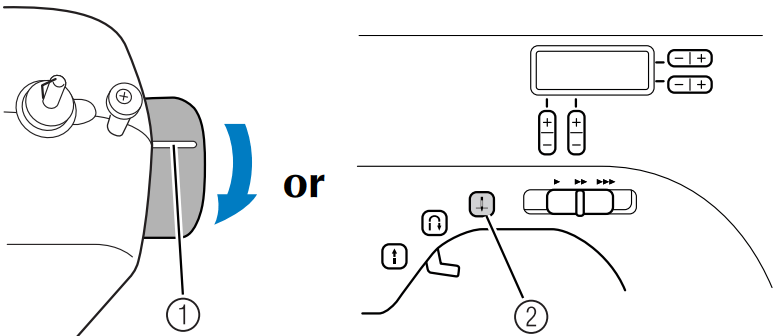
(1) Mark
(2) Needle position button
If the needle is not correctly raised, the sewing machine can not be threaded. Be sure to turn the handwheel so that the mark on the wheel points up before threading the sewing machine.
3. Pull up the spool pin as far as possible, and then put a spool of thread on this pin.
CAUTION: If the spool of thread is in the wrong place, or is set incorrectly, the thread may tangle on the spool pin and cause the needle to break.
4. Feed the upper thread as illustrated below.
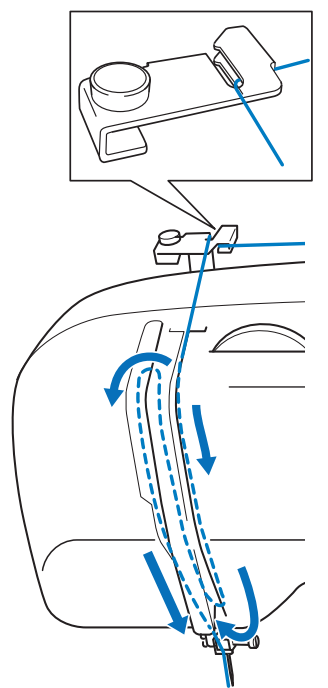
5. Make sure you guide the thread through the thread take-up lever from right to left.
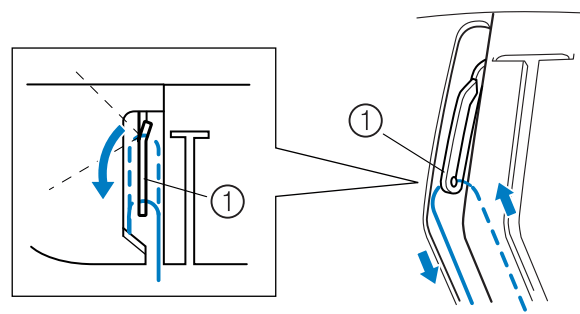
(1) Thread take-up lever
6. Put the thread behind the needle bar thread guide.
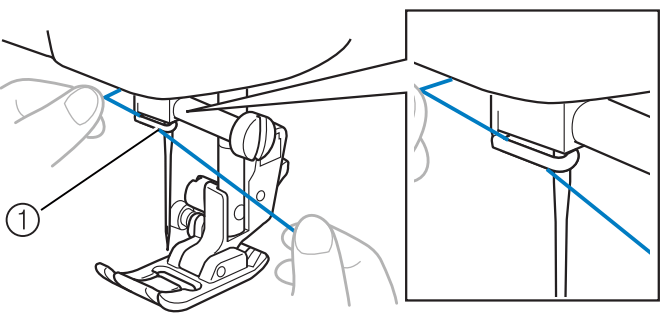
(1) Needle bar thread guide
7. Thread the needle from front to back and pull out about 5 cm (2 inch) of thread.
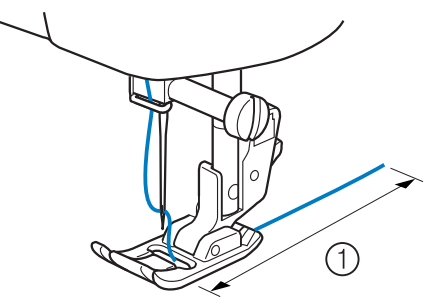
(1) 5 cm (2 inch)
Note:
- If the thread take-up lever is lowered, the upper thread cannot be wrapped around the thread take-up lever. Make sure you raise the presser foot lever and the thread take-up lever before you feed the upper thread.
- If you incorrectly feed the thread you may cause sewing problems.
Using the needle threader (for models equipped with the needle threader)
CAUTION: You cannot use the needle threader if you are using decorative threads or special needles, such as the twin needle and wing needle. If you are using those types of threads or needles, thread the eye of the needle by hand. Make sure the main power switch is off when threading the needle by hand.
1. Follow steps 1 through 6 of the procedure in “Upper threading”.
2. Lower the presser foot lever.
3. While lowering the needle threader lever, hook the thread onto the guide.
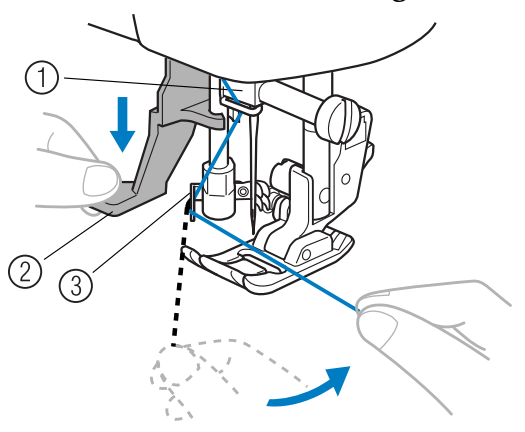
(1) Needle holder
(2) Needle threader lever
(3) Guide
4. Fully lower the needle threader lever.

The hook passes through the eye of the needle, and catch the thread.
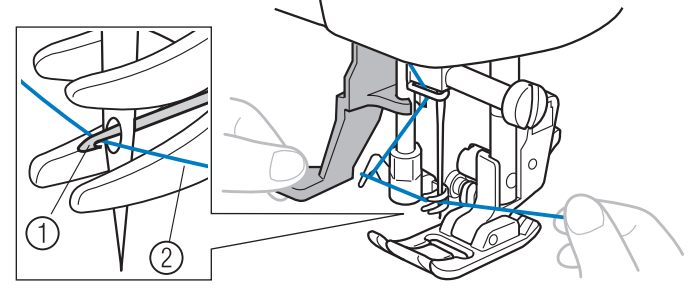
(1) Hook
(2) Thread
5. Release the needle threader lever. Then pull the loop of the thread.

6. Pass the end of the thread as illustrated bellow.
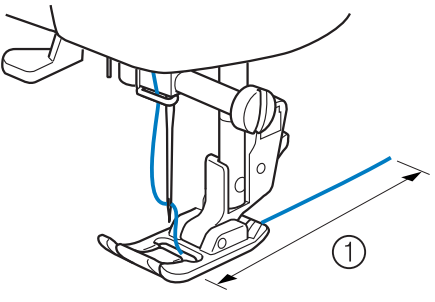
(1) 5 cm (2 inch)
Note: If you incorrectly feed the thread you may cause sewing problems.
Drawing up the lower thread
1. Lightly hold the end of the upper thread
.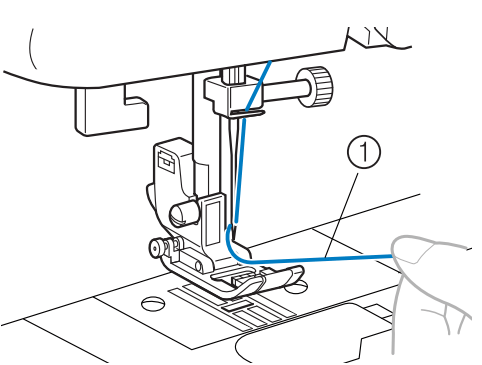
(1) Upper thread
2. While holding the end of the upper thread, raise the needle either by turning the handwheel toward you (counterclockwise) so that the mark on the wheel points up or by pressing  (needle position button) (for models equipped with the needle position button) once or twice.
(needle position button) (for models equipped with the needle position button) once or twice.

(1) Mark
(2) Needle position button
3. Pull on the upper thread to draw up the lower thread.
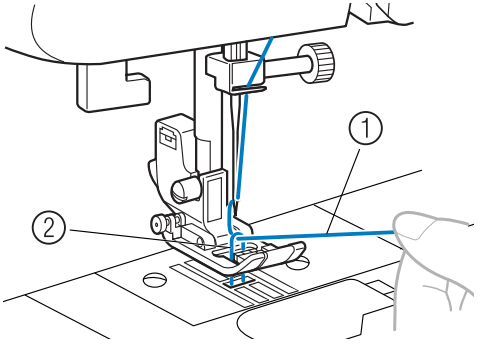
(1) Upper thread
(2) Lower thread
4. Pull out about 10 cm (4 inch) of both threads and pull them toward the back of the machine under the presser foot.

(1) Upper thread
(2) Lower thread
For models equipped with the quick-set bobbin
You can begin sewing immediately without drawing up the bobbin thread. When sewing gathers or darts, you can draw up the lower thread by hand so that some thread will be left over. Before you draw up the lower thread, put the bobbin back in.
1. Pass the thread along the slit in the direction of the arrow, and leave it there without cutting it.
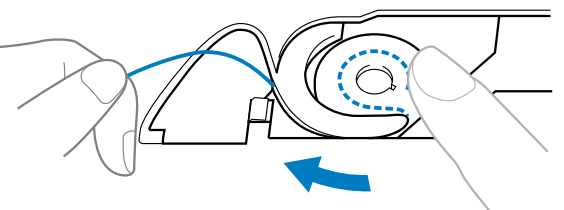
The bobbin cover should still be removed.
2. Draw up the lower thread as described in steps 1 to 4
3. Replace the bobbin cover.
REPLACING THE NEEDLE
Needle types and their uses
CAUTION:
- Only use home sewing machine needles. Use of any other needle may bend the needle or damage the machine.
- Never use bent needles. Bent needles can easily break, possibly resulting in injury.
The sewing machine needle that should be used depends on the fabric and thread thickness.
| Fabric Type/Application | Thread | Size of Needle | ||
| Type | Size | |||
| Medium weight fabrics | Broad-cloth | Cotton thread | 60-80 | 75/11-90/14 |
| Taffeta | Synthetic thread | |||
| Flannel, Gabardine | Silk thread | 50-80 | ||
| Thin fabrics | Lawn | Cotton thread | 60-80 | 65/9-75/11 |
| Georgette | Synthetic thread | |||
| Challis, Satin | Silk thread | 50-80 | ||
| Thick fabrics | Denim | Cotton thread | 30-50 | 90/14-100/16 |
| Corduroy | Synthetic thread | 50 | ||
| Tweed | Silk thread | |||
| Stretch fabrics | Jersey | Thread for knits | 50-60 | Ball point needle (golden colored) 75/11-90/14 |
| Tricot | ||||
| Easily frayed fabrics | Cotton thread | 50-80 | 65/9-90/14 | |
| Synthetic thread | ||||
| Silk thread | ||||
| For top-stitching | Synthetic thread | 30 | 90/14-100/16 | |
| Silk thread | ||||
Memo:
- The smaller the thread number, the thicker the thread; and the larger the needle number, the thicker the needle.
- Use the ball point needle when sewing on stretch fabrics or fabrics where skipped stitches easily occur.
- Use a 90/14 to 100/16 needle with transparent nylon threads, regardless of the fabric being sewn.
Ball point needle
Use the ball point needle when sewing on stretch fabrics or fabrics where skipped stitches easily occur.
Use the ball point needle for best results when sewing patterns using monogramming foot “N”.
Transparent nylon thread
Use a 90/14 to 100/16 needle, regardless of the fabric or thread.
CAUTION: The appropriate fabric, thread and needle combinations are shown in the preceding table. If the combination of the fabric, thread and needle is not correct, particularly when sewing thick fabrics (such as denim) with thin needles (such as 65/9 to 75/11), the needle may bend or break. In addition, the stitching may be uneven or puckered or there may be skipped stitches.
Checking the needle
Sewing with a bent needle is extremely dangerous since the needle may break while the machine is being operated.
Before using the needle, place the flat side of the needle on a flat surface and check that the distance between the needle and the flat surface is even.
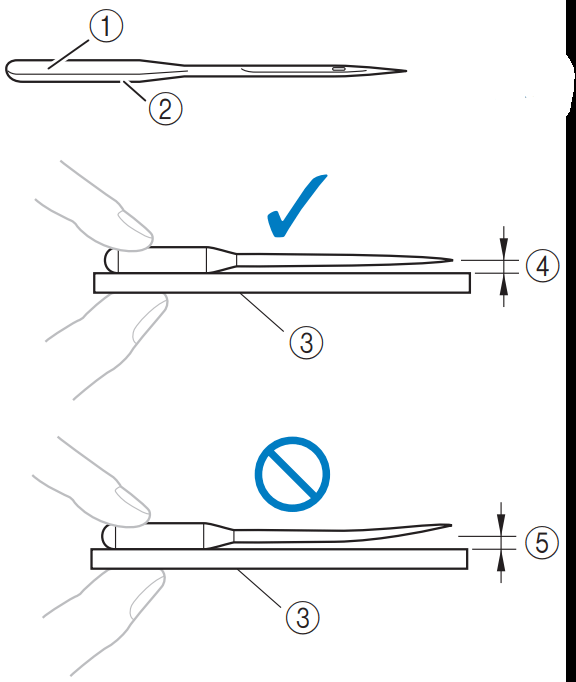
(1) Flat side
(2) Needle type marking
(3) Flat surface
(4) Even
(5) Not even
Replacing the needle
1. Raise the needle by turning the handwheel toward you (counterclockwise) so that the mark on the wheel points up. (With models equipped with  (needle position button), raise the needle by pressing
(needle position button), raise the needle by pressing  once or twice.)
once or twice.)
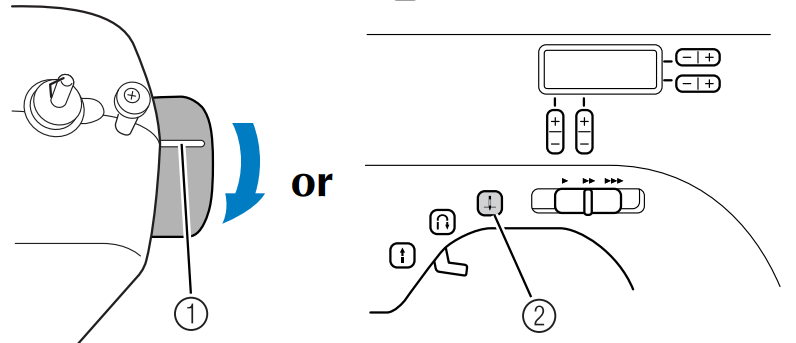
(1) Mark
(2) Needle position button
2. Turn off the sewing machine.
CAUTION: Before replacing the needle, be sure to turn off the sewing machine, otherwise injuries may occur if the foot controller or the start/stop button is accidentally pressed and the machine starts sewing.
3. Lower the presser foot lever.
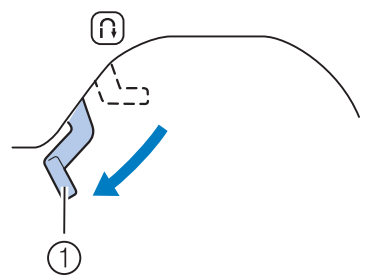
(1) Presser foot lever
4. Remove the needle by turning the needle clamp screw counterclockwise.
Note: If the needle clamp screw is loosened too much, the needle clamp (which holds the needle) may fall off. Therefore, do not loosen the needle clamp screw too much.
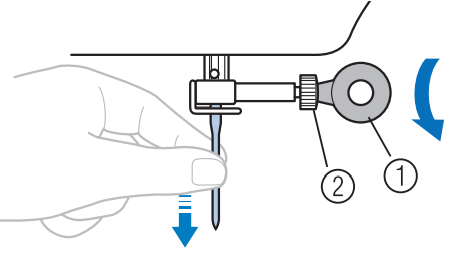
(1) Disc-shaped screwdriver
(2) Needle clamp screw
Do not apply strong force when loosening or tightening the needle clamp screw, otherwise certain parts of the sewing machine may be damaged.

5. With the flat side of the needle toward the rear of the machine, insert the needle until it touches the needle stopper.
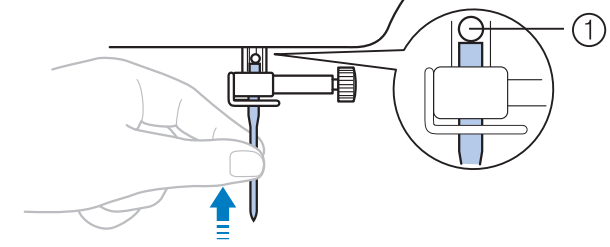
(1) Needle stopper
6. Tighten the needle clamp screw by turning it clockwise.
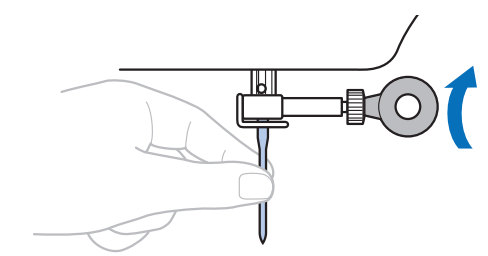
Install the twin needle in the same way

CAUTION: Be sure to insert the needle until it touches the needle stopper and securely tighten the needle clamp screw with the disc-shaped screwdriver, otherwise the needle may break or damage may result.
Installing the needle clamp
If the needle clamp is removed, follow the procedure below to attach it to the needle bar.
1. As seen from the front of the machine, slide the needle clamp onto the needle bar so that the needle clamp screw is on the right side and the needle bar thread guide is at the bottom.
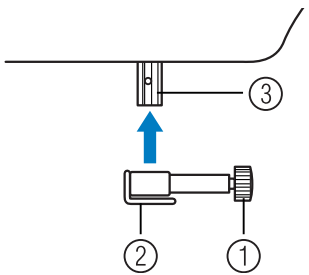
(1) Needle clamp screw
(2) Needle bar thread guide
(3) Needle bar
2. Align the bottom edge of the needle holder with the end of the needle bar, and then tighten the needle clamp screw.
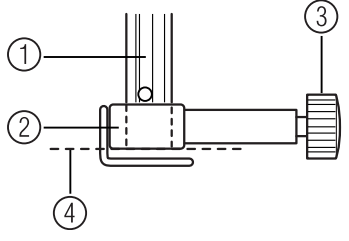
(1) Needle bar
(2) Needle holder
(3) Needle clamp screw
(4) Align
Sewing with a twin needle
You can sew with this needle and two top threads. You can use the same color or two different colors of thread for making decorative stitches.
CAUTION:
- Use only twin needles that have been made for this machine (part code: 131096-121). Other needles could break, and damage the machine.
- Do not sew with bent needles. The needle could break and injure you.
- You can not use the needle threader to thread the twin needle. Instead, thread the twin needle by hand, from front to back. Using the needle threader may damage the machine.
- When using the twin needle, be sure to select an appropriate stitch, otherwise the needle may break or the machine may be damaged.
- Select a stitch width of 5.0 mm (3/16 inch) or less, otherwise the needle may break or the machine may be damaged.
- After adjusting the stitch width, slowly turn the handwheel toward you (counterclockwise) and check that the needle does not touch the presser foot. If the needle hits the presser foot, the needle may bend or break.
- When using the twin needle, be sure to attach zigzag foot “J”, otherwise the needle may break or the machine may be damaged.
- When changing the sewing direction, be sure to raise the needle before turning the fabric. If the fabric is turned while the needle is lowered, the needle may bend or break.
1. Attach the twin needle
2. Attach the extra spool pin.
Put the extra spool pin in the hole on the top of the machine. Put the second spool of thread onto the extra spool pin

(1) First spool
(2) Second spool
3. Use the thread from the first spool to thread the machine to the needle bar thread guide.
The path for threading the machine to the needle bar thread guide is the same as for normally threading the machine (for a single needle).
4. Thread the left needle from front to back.
5. Use the thread from the second spool to thread the machine to the thread take-up lever.
The path for threading the machine to the thread take-up lever is the same as for normally threading the machine (for a single needle).
6. Thread the right needle from front to back.
Do not pass the thread behind the needle bar thread guide.
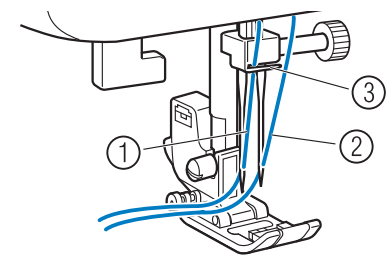
(1) Left needle thread passes through the needle bar thread guide.
(2) Right needle thread passes in front of the needle bar thread guide.
(3) Needle bar thread guide
Note: Models equipped with a needle threader
You cannot use the needle threader to thread the twin needle. Instead, thread the twin needle by hand, from front to back. Using the needle threader may damage the machine.
CAUTION: When using the twin needle, be sure to attach zigzag foot “J”, otherwise the needle may break or the machine may be damaged.
REPLACING THE PRESSER FOOT
CAUTION:
- Always turn off the power before you change the presser foot. If you leave the power on and step on the controller, the machine will start and you may be injured.
- Always use the correct presser foot for the stitch pattern you have chosen. If you use the wrong presser foot, the needle may strike the presser foot and bend or break, and may cause injury.
- Only use presser feet that have been designed to be used with this machine. Using other any presser feet may cause an accident or injury.
Replacing the presser foot
1. Raise the needle by turning the handwheel toward you (counterclockwise) so that the mark on the wheel points up. (With models equipped with  (needle position button), raise the needle by pressing
(needle position button), raise the needle by pressing  once or twice.)
once or twice.)
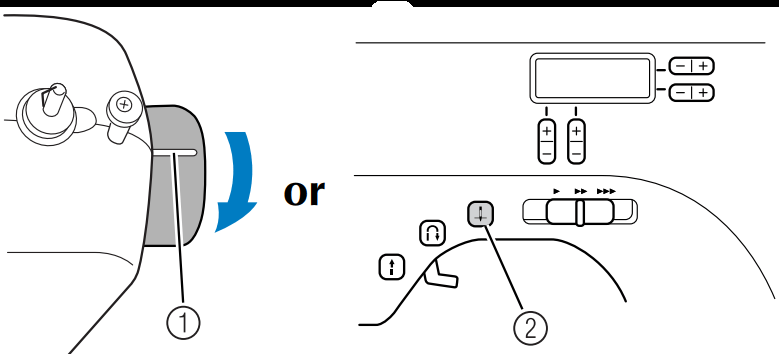
(1) Mark
(2) Needle position button
2. If the sewing machine has been turned on, turn it off
CAUTION: Before replacing the presser foot, be sure to turn off the sewing machine, otherwise injuries may occur if the foot controller or the start/stop button is accidentally pressed and the machine starts sewing.
3. Raise the presser foot lever
4. Press the black button release the presser foot.
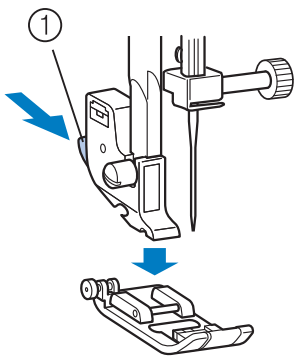
(1) Black button
5. Place a different presser foot below the holder so that the presser foot pin is aligned with the shank in the holder.
Position the presser foot so the letter indicating the presser foot type (J, A, etc.) is positioned to be read.
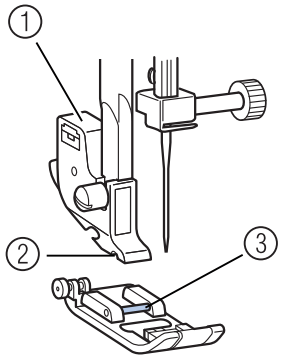
(1) Presser foot holder
(2) Shank
(3) Pin
Note: The presser foot to be used with each stitch appears in the LCD. To select a stitch, refer to “Selecting stitching”
6. Slowly lower the presser foot lever so that the presser foot pin snaps into the shank.
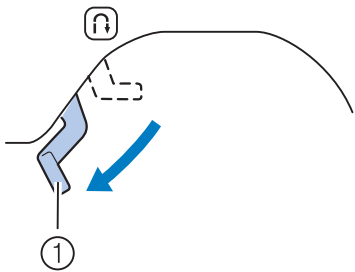
(1) Presser foot lever
The presser foot is attached
7. Raise the presser foot lever to check that the presser foot is securely attached
Removing the presser foot holder
Remove the presser foot holder when cleaning the sewing machine or when installing a presser foot that does not use the presser foot holder, such as the quilting foot. Use the disc-shaped screwdriver to 1 remove the presser foot holder
Removing the presser foot holder
1. Remove the presser foot.
2. Loosen the presser foot holder screw.
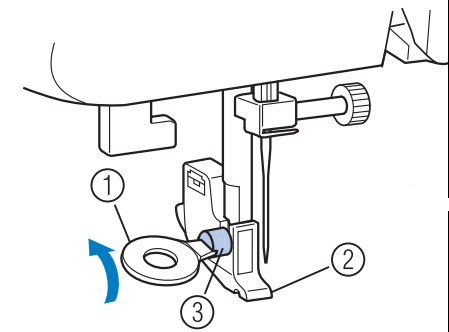
(1) Disc-shaped screwdriver
(2) Presser foot holder
(3) Presser foot holder screw
Attaching the presser foot holder
1. Align the presser foot holder with the lower-left side of the presser bar.

(1) Presser foot holder
(2) Presser bar
2. Holding the presser foot holder in place, tighten the screw
Note: If the presser foot holder is not correctly installed, the thread tension will be incorrect.
SEWING
CAUTION:
- While the machine is in operation, pay special attention to the needle location. In addition, keep your hands away from all moving parts such as the needle and handwheel, otherwise injuries may occur.
- Do not pull or push the fabric too hard while sewing, otherwise injuries may occur or the needle may break.
- Never use bent needles. Bent needles can easily break, possibly resulting in injuries.
- Make sure that the needle does not strike basting pins, otherwise the needle may break or bend.
General sewing procedure
- Turn on the machine
- Select the stitch appropriate for the area to be sewn
- Attach the presser foot appropriate for the stitch
- Start sewing: Position the fabric, and then start sewing. When sewing is finished, cut the thread
ADJUSTING THE STITCH LENGTH AND WIDTH
Selecting stitching
Using the stitch selection keys, select the desired stitch. When the sewing machine is turned on, the straight stitch (  left needle position) is selected.
left needle position) is selected.
1. Turn on the sewing machine
2. Press  (stitch selection keys). The number of the selected stitch is displayed.
(stitch selection keys). The number of the selected stitch is displayed.

(1) Designate tens digit
(2) Designate the ones digit
The stitch is selected
3. Attach the presser foot indicate in the LCD
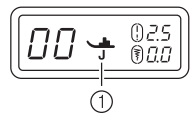
(1) Presser foot type
[Example] Selecting stitch  .
.
1. Press the stitch selection keys to select stitch 04.
With  on the right, select “4”, and with
on the right, select “4”, and with  on the left, select “0”.
on the left, select “0”.
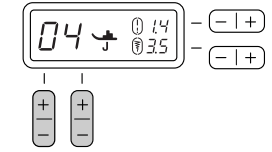
2. Press the “+” or “–” side of  (stitch length adjustment key) to increase or reduce the stitch length.
(stitch length adjustment key) to increase or reduce the stitch length.

(1) Stitch length adjustment key
(2) Short
(3) Long
3. Press the “+” or “–” side of  (stitch length adjustment key) to increase or reduce the stitch length.
(stitch length adjustment key) to increase or reduce the stitch length.

(1) Stitch width adjustment key
(2) Narrow
(3) Wide
Note:
- When the stitch length or stitch width is changed from the standard setting,
 around
around  or
or  disappears from the LCD.
disappears from the LCD. - If the stitch width of the selected stitch cannot be adjusted, “--” appears to the right of
 in the LCD.
in the LCD.
CAUTION:
- After adjusting the stitch width, slowly turn the handwheel toward you (counterclockwise) and check that the needle does not touch the presser foot. If the needle hits the presser foot, the needle may bend or break.
- If the stitches are bunched together, increase the stitch length. Continuing to sew with the stitches bunched together may result in the needle bending or breaking.
Starting to sew
1. Raise the needle by turning the handwheel toward you (counterclockwise) so that the mark on the wheel points up. (With models equipped with  (needle position button), raise the needle by pressing
(needle position button), raise the needle by pressing  once or twice.)
once or twice.)

(1) Mark
(2) Needle position button
2. Raise the presser foot lever.

(1) Presser foot lever
3. Place the fabric under the presser foot, pass the thread under the presser foot, and then pull out about 5 cm (2 inch) of thread toward the rear of the machine.
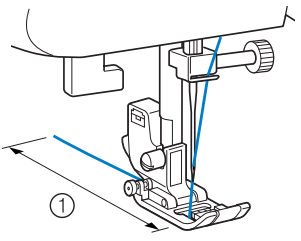
(1) 5 cm (2 inch)
4. While holding the end of the thread and the fabric with your left hand, turn the handwheel toward you (counterclockwise) with your right hand to lower the needle to the starting point of the stitching.

5. Lower the presser foot lever
6. On models equipped with a sewing speed controller, slide the sewing speed controller to the left or right to adjust the sewing speed.

(1) Sewing speed controller
7. Slowly press down on the foot controller. (With models equipped with  (start/stop button), if the foot controller is not connected, press
(start/stop button), if the foot controller is not connected, press  once.)
once.)
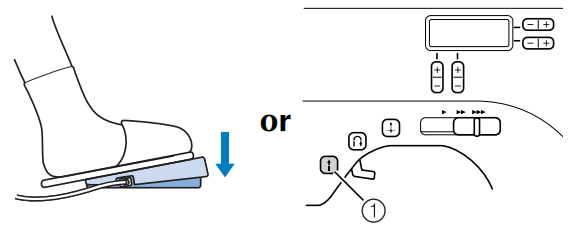
(1) Start/stop button
The machine starts sewing.
8. Take your foot off the floor controller, or press  (start/stop button) once (if the machine was started by pressing
(start/stop button) once (if the machine was started by pressing  (start/stop button)) (for models equipped with the start/stop button)
(start/stop button)) (for models equipped with the start/stop button)
The machine stops sewing.
9. Raise the needle by turning the handwheel toward you (counterclockwise) so that the mark on the wheel points up. (With models equipped with  (needle position button), raise the needle by pressing
(needle position button), raise the needle by pressing  once or twice.)
once or twice.)
10. Raise the presser foot lever.
11. Pull the fabric to the left side of the machine, and then cut the threads by using the thread cutter.
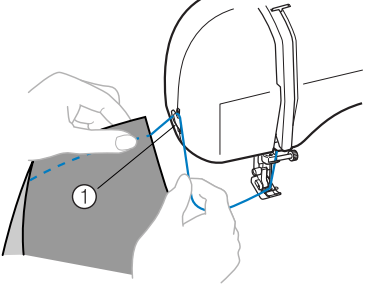
(1) Thread cutter
Memo:
When the foot controller is plugged in,  (start/stop button) cannot be used to start or stop sewing.
(start/stop button) cannot be used to start or stop sewing.
When sewing is stopped, the needle remains lowered (in the fabric). The machine can be set so that the needle will stay up when sewing is stopped.
Sewing reinforcement stitches
When sewing stitches other than straight or zigzag stitches that are secured with reverse stitching, pressing  (reverse/reinforcement stitch button) sews reinforcement stitches, 3 to 5 stitches on top of each other.
(reverse/reinforcement stitch button) sews reinforcement stitches, 3 to 5 stitches on top of each other.
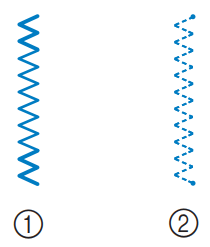
(1) Reverse stitching
(2) Reinforcement stitching
Memo: Whether reverse stitches or reinforcement stitches are sewn depends on the stitch that is selected.
Thread tension
The thread tension will affect the quality of your stitches. You may need to adjust it when you change fabric or thread.
Memo: We recommend that you do a test sample on scrap of a fabric before you start to sew.
Correct tension
Correct tension is important as too much or too little tension will weaken your seams or cause puckers on your fabric
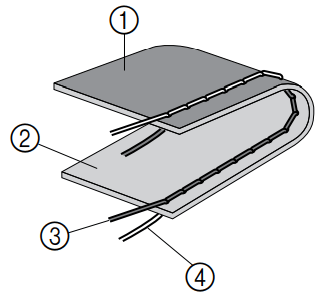
(1) Wrong side
(2) Surface
(3) Upper thread
(4) Lower thread
Upper tension is too tight
Loops will appear on the surface of the fabric.

(1) Wrong side
(2) Surface
(3) Upper thread
(4) Lower thread
(5) Loops appear on surface of fabric
Solution
Reduce the tension by turning the upper tension-control dial to a lower number.

Upper tension is too loose
Loops appear on the wrong side of the fabric.

(1) Wrong side
(2) Surface
(3) Upper thread
(4) Lower thread
(5) Loops appear on wrong side of fabric
Solution
Increase the tension by turning the upper tension-control dial to a higher number.

MAINTENANCE
Restrictions on oiling
In order to prevent damaging this machine, it must not be oiled by the user.
This machine was manufactured with the necessary amount of oil applied to ensure correct operation, making periodic oiling unnecessary.
If problems occur, such as difficulty turning the handwheel or an unusual noise, immediately stop using the machine, and contact your authorized dealer or the nearest authorized service center.
Precautions on storing the machine
Do not store the machine in any of the locations described below, otherwise damage to the machine may result, for example, rust caused by condensation.
- Exposed to extremely high temperatures
- Exposed to extremely low temperatures
- Exposed to extreme temperature changes
- Exposed to high humidity or steam
- Near a flame, heater or air conditioner
- Outdoors or exposed to direct sunlight
Exposed to extremely dusty or oily environments
Note: In order to extend the life of this machine, periodically turn it on and use it. Storing this machine for an extended period of time without using it may reduce its efficiency.
Cleaning the machine surface
If the surface of the machine is dirty, lightly soak a cloth in neutral detergent, squeeze it out firmly, and then wipe the surface of the machine. After cleaning it once with a wet cloth, wipe it again with a dry cloth.
CAUTION: Unplug the power supply cord before cleaning the machine, otherwise injuries or an electric shock may occur.
Cleaning the bobbin case
Sewing performance will suffer if dust collects in the bobbin case; therefore, it should be cleaned periodically.
CAUTION: Make sure you unplug the machine before you clean it. Otherwise, you may get an electric shock or be injured.
1. Switch the machine off and unplug it.
2. Raise the needle and the presser foot.
3. Loosen the presser-foot screw and the needle clamp screw to remove the presser-foot holder and the needle
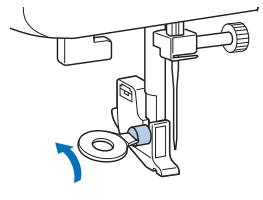
4. Grasp both sides of the needle plate cover, and then slide it toward you to remove the needle plate cover.
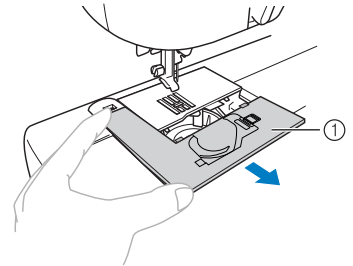
(1) Needle plate cover
5. Remove the bobbin case.
Grasp the bobbin case, and then pull it out.
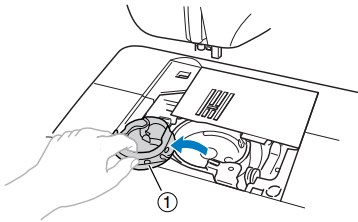
(1) Bobbin case
6. Use the cleaning brush or a vacuum cleaner to remove any dust from the race and its surrounding area.
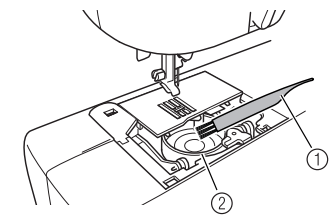
(1) Cleaning brush
(2) Race
Do not put oil on the bobbin case
7. Insert the bobbin case so that the  mark on the bobbin case aligns with the
mark on the bobbin case aligns with the  mark on machine as shown below.
mark on machine as shown below.
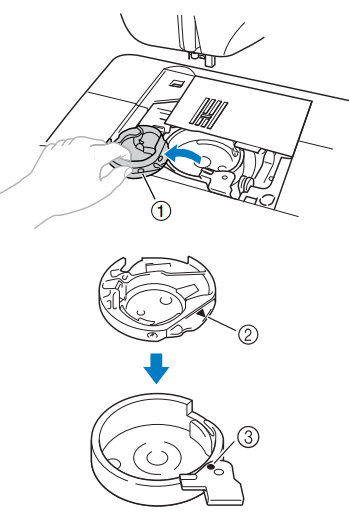
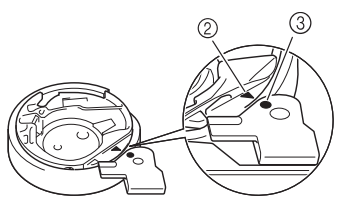
Align the  and
and  marks.
marks.
(1) Bobbin case
(2)  mark
mark
(3)  mark
mark
Make sure that the indicated points are aligned before installing the bobbin case.
CAUTION:
- Never use a bobbin case that is scratched, otherwise the upper thread may become tangled, the needle may break or sewing performance may suffer. For a new bobbin case (part code: XE7560-001), contact your nearest 4 authorized service center.
- Make sure that you fit the bobbin case properly, otherwise the needle may break.
8. Put the tabs on the needle plate cover into the needle plate, and then slide the cover back on.

TROUBLESHOOTING
If the machine stops working properly, check the following possible problems.
If the problem it still there, contact your retailer or the nearest authorised service center.
| Symptom | Possible cause | How to put it right |
|---|---|---|
| The sewing machine does not work | The machine is not plugged in. | Plug the machine in. |
The main power switch is turned off. | Turn on the main power switch. | |
| The bobbin winder shaft is pushed to the right | Move the bobbin winder shaft to the left | |
| You have not used the foot controller properly | Use the foot controller properly | |
| The needle breaks | The needle is not fitted properly. | Fit the needle properly. |
The needle clamp screw is loose. | Use the disc-shaped screwdriver to firmly tighten the screw. | |
| The needle is bent or blunt. | Replace the needle. | |
| You have not used the right combination of fabric, thread and needle | Choose a thread and needle that are appropriate for the type of fabric. | |
| The presser foot you are using is not appropriate for the type of stitch that you want to sew. | Attach the presser foot that is correct for the type of stitch that you want to screw. | |
| The upper thread tension is too tight. | Loosen the upper thread tension. | |
| You are pulling the fabric too much. | Lightly guide the fabric. | |
| The area around the hole in the needle plate is scratched. | Replace the needle plate. Contact your retailer or the nearest authorized service center. | |
| The area around the hole in the presser foot is scratched. | Replace the presser foot. Contact your retailer or the nearest authorized service center. | |
| The bobbin case is scratched. | Replace the bobbin case. Contact your retailer or the nearest authorized service center. | |
| You have not used a bobbin that has been designed for this machine. | Incorrect bobbins will not work properly. Only use a bobbin that has been designed for this machine. | |
| The upper thread breaks | You have not threaded the upper thread properly. (for example, you have not fitted the spool properly, or the thread has come out of the guide above the needle.) | Correct the upper threading. |
| There are knots or tangles in the thread. | Remove any knots or tangles. | |
| The needle is not appropriate for the thread you are using. | Choose a needle that is appropriate for the type of stitch. | |
| The upper thread tension is too tight. | Loosen the upper thread tension. | |
| The thread is tangled, for example, in the bobbin case. | Remove the tangle thread. If the thread is tangled in the bobbin case, clean the bobbin case. | |
| The needle is bent or blunt. | Replace the needle. | |
| You have not inserted the needle properly. | Insert the needle properly. | |
| The area around the hole in the needle plate is scratched. | Replace the needle plate. Contact your retailer or the nearest authorized service center. | |
| The area around the hole in the presser foot is scratched. | Replace the presser foot. Contact your retailer or the nearest authorized service center | |
| The bobbin case is scratched, or has a burr on it. | Replace the bobbin case. Contact your retailer or the nearest authorized service center | |
| You have not used a bobbin that has been designed for this machine. | Incorrect bobbins will not work properly. Only use a bobbin that has been designed for this machine. | |
| The lower thread is tangled or breaks. | You have not wound the bobbin thread properly. | Wind the bobbin thread properly. |
| The bobbin is scratched or does not turn smoothly. | Replace the bobbin. | |
| The thread is tangled. | Remove the tangled thread and clean the bobbin case. | |
| You have not used a bobbin that has been designed for this machine. | Incorrect bobbins will not work properly. Only use a bobbin that has been designed for this machine. | |
| Bobbin is set incorrectly. | Reset the bobbin thread correctly. | |
| The thread tension is incorrect. | You have not threaded the upper thread properly. | Correct the upper threading. |
| You have not wound the bobbin thread properly. | Wind the bobbin thread properly. | |
| You have not threaded the right combination of thread and needle for the fabric you are using. | Choose a thread and needle that are appropriate for the type of fabric. | |
| You have not attached the presser foot holder properly. | Attach the presser-foot holder properly | |
| The thread tension is incorrect. | Adjust the tension of the upper thread. | |
| You have not used a bobbin that has been designed for this machine. | Incorrect bobbins will not work properly. Only use a bobbin that has been designed for this machine. | |
| Bobbin is set incorrectly. | Reset the bobbin thread correctly. | |
| The fabric is wrinkled | You have not threaded the upper thread properly or fitted the bobbin properly. | Thread the upper thread and wind the bobbin thread properly. |
| You have not fitted the spool properly. | Fit the spool properly. | |
| You have not used the right combination of fabric, thread and needle. | Choose a thread and needle that are appropriate for the type of fabric. | |
| The needle is bent or blunt. | Replace the needle. | |
| If you are sewing thin fabric, the stitch is too thick. | Sew with stabiliser material under the fabric. | |
| The thread tension is incorrect. | Adjust the tension of the upper thread | |
| Stitches are skipped | You have not threaded the upper thread properly. | Correct the upper threading. |
| You have not used the right combination of fabric, thread and needle. | Choose a thread and needle that are appropriate for the type of fabric. | |
| The needle is bent or blunt. | Replace the needle. | |
| You have not inserted the needle properly. | Insert the needle properly. | |
| Dust has accumulated under the needle plate or in the bobbin case. | Remove the needle plate cover and clean the plate and the bobbin case. | |
| There is a high-pitched noise while sewing. | Dust has built up in the feed dogs or in the bobbin case. | Clean the bobbin case. |
| You have not threaded the upper thread properly. | Correct the upper threading. | |
| The bobbin case is scratched. | Replace the bobbin case. | |
| You have not used bobbin that has been designed for this machine. | Incorrect bobbins will not work properly. Only use a bobbin that has been designed for this machine. | |
| The needle threader can not be used | You have not moved the needle holder to its highest position. | Raise the needle either by turning the handwheel toward you (counterclockwise) so that the mark on the wheel points up or by pressing  (needle position button) once or twice. (needle position button) once or twice. |
| You have not inserted the needle properly. | Insert the needle properly. | |
| The stitch is not sewn correctly | The presser foot that you are using is not correct for the type of stitch. | Attach the presser foot that is correct for the type of stitch that you want to sew. |
| The thread tension is incorrect. | Adjust the tension of the upper thread. | |
| The thread is tangled, for example, in the bobbin case. | Remove the tangle thread. If the thread is tangled in the bobbin case, clean the bobbin case. | |
| The fabric does not feed | The feed dogs are lowered. | Slide the feed dog position lever to  |
| The stitch is too fine. | Lengthen the stitch length. | |
| You have not used the right combination of fabric, thread and needle. | Choose a thread and needle that are appropriate for the type of fabric. | |
| The thread is tangled, for example, in the bobbin case. | Remove the tangle thread. If the thread is tangled in the bobbin case, clean the bobbin case. | |
| The sewing light bulb does not come on. | The sewing lamp is damaged. | Contact your retailer or the nearest authorized service center. |
ERROR MESSAGES
If an operation is performed incorrectly before the sewing machine is set up, an error message appears on the operation panel. Follow the instructions indicated in the table.
If you press the stitch selection key or do the operation correctly while the error message is displayed, the message disappears.
| Error message | Probable Cause | Solution |
 | The foot controller was pressed (or the start/stop button was pressed if the foot controller is not connected) and the reverse/reinforcement stitch button was pressed while the presser foot is raised. | Lower the presser foot lever before continuing the operation |
 | A stitch other than the buttonhole or bar tack stitch was selected and the foot controller was pressed (or the start/stop button was pressed if the foot controller is not connected) while the buttonhole lever is lowered. | Raise the buttonholder lever before continuing the operation |
 | The buttonhole or bar tack stitch was selected and the foot controller was pressed (or the start/stop button was pressed if the foot controller is not connected) while the buttonhole lever is raised. | Lower the buttonhole lever before continuing the operation. |
 | The reverse/reinforcement stitch button or needle position button was pressed while the bobbin winder shaft is moved to the right. | Move the bobbin winder shaft to the left before continuing the operation. |
 | The start/stop button was pressed while the foot controller was connected. | Disconnect the foot controller, and then press the start/stop button. Otherwise operate the machine by using the foot controller. |
 | The motor locked up because the thread is tangled. | Remove the tangled thread before continuing the operation. |
Note: If error message “F1” through “F8” appears in the LCD while the sewing machine is being used, the machine may be malfunctioning. Contact your nearest authorized service center.
Operation beep (for models equipped with the operation beep)
Each time a key is pressed you will hear one beep. If a non-functioning key is pressed or an incorrect operation is performed you will hear two or four beeps (only for models equipped with the operation beep).
If a key is pressed (correct operation)
One beep sounds.
If an incorrect operation is performed or a non-functioning key is pressed
Two or four beeps sound.
If the machine locks up, for example, because the thread is tangled
The sewing machine beeps for four seconds and the machine automatically stops. Be sure to check for the cause of the error, and correct it before continuing to sew.
See other models: CM550DX / CM550 HL-L6200DW(T) XL-5700 BM-3600 PT-2030AD
